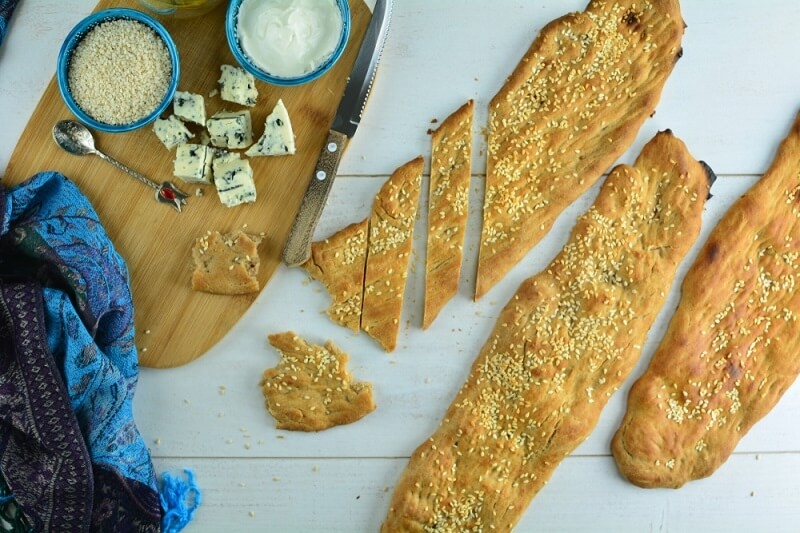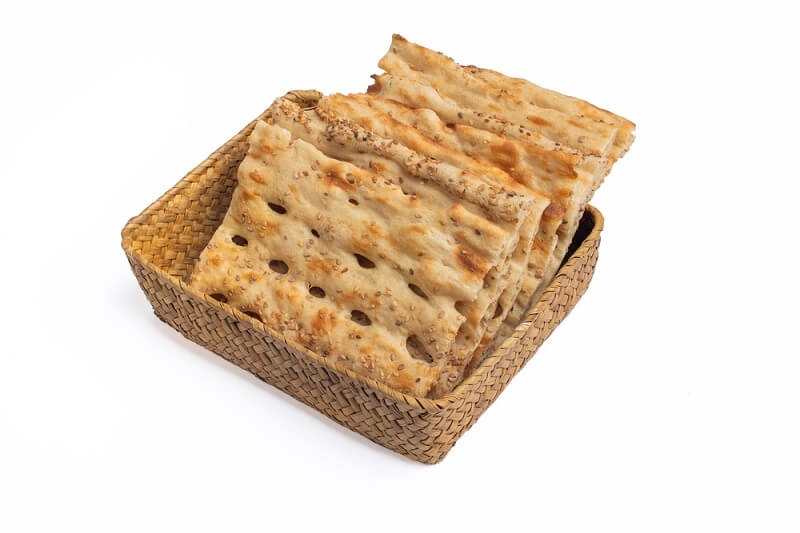Persian Crusty Bread Traditional Baking and Modern Recipes

There are few things better than the smell of fresh-baked bread in a home. In Iran, that smell is considered a national heirloom representing warmth, family, and history. The bread that is the focus of this ritual is generally known as Persian “sangak,” meaning “little stones,” referring to the small stones used in baking. This bread is characterized by its delicious contrast between the crusty exterior and soft, airy interior. For many, making this bread can seem overwhelming, but we will show that it is easily achievable.
This article will showcase an easy Iranian bread recipe; better yet, you won’t even need a tanoor to make it. There is no longer a need to look for a special bakery that uses authentic tandoor ovens; you’ll be able to recreate a very similar crusty flatbread yourself and enjoy the fruity aroma of freshly baked bread without taking a memorable trip. Let’s start making this straightforward Persian flatbread recipe that hopefully will bring the spirit of a Persian kitchen into your own.
History and Cultural Significance of Persian Bread
In Iranian culture, bread is not just food; it is seen as a source of life and a means to promote community. Families eat meals around freshly baked bread, bakers across Iran take pride in their profession, and crusty Persian bread symbolizes hospitality and tradition in all environments—from crowded bazaars to quiet towns across the Middle East.
- Bread as a Cultural Connector (The role of bread in hospitality/status)
- Served at nearly every meal (Essential to the great majority of people in Iran)
- Used to scoop stews, dips, and spreads (Size, shape, & preparation enable it to do this)
- Offered to guests as a gesture of respect (Bread and tea are the most important in Iranian hospitality)
- Symbolizes prosperity, & nourishment (Bread and tea symbolize increased social status, and having food to eat daily)
Characteristics of Persian Crusty Bread
What is special about Persian crusty bread compared to more traditional forms?
- Crispy, golden-brown crust: This is also due to consistently high temperatures while preparing the dough.
- Soft inside: This bread is light, fluffy, and complements the crusty crunch.
- Unique scoring or patterned look: Conventional techniques are employed to ensure bread has a recognizably unique look, as they traditionally do.
- Versatile: It can be served with soups and stews or kebabs or kept plain for edible enjoyment.
These qualities have made it among the most loved and sought-after forms of crusty flatbread across the globe.
Persian Flatbread Recipe Basics
A classic Persian flatbread recipe consists of:
- All-purpose or whole wheat flour
- Water (warm up to activate yeast)
- Yeast (instant or active dry)
- Salt
- Margarine or butter (for additional softness)
Step-by-Step Method
- Mix the warm water and yeast until you get a foamy mixture
- Add the flour and salt; knead into a smooth dough
- Let rise to double in size
- Portion and form into flat rounds
- Bake in a hot oven until golden and crusty
This recipe can be modified into an easy Iranian bread or an even quicker Persian bread version with fewer ingredients.
Baking Persian Bread at Home
If you enjoy authentic flavors, you might like to discover that making Persian bread at home isn’t too tricky.
Tips for Successful Baking
- Use a pizza stone or heavy baking sheet to replicate clay ovens.
- Don't dry your dough out; keep it a bit sticky to produce the right texture.
- Spritz loaves of Persian bread with water before putting them in the oven for a shinier crust.
- Be patient and let your dough rise fully; it adds flavor and texture.
If you want to learn, you can create bakery-style Persian crusty bread without leaving home.
Easy Iranian Bread for Beginners

If you are new to making bread, try a straightforward Iranian recipe.
- You will want to use self-rising flour to speed up the process.
- By eliminating all the complicated shaping, you can make dough rounds.
- Also, it is best to bake the bread at a slightly lower temperature so it doesn't burn.
This will allow you to recreate the spirit of the traditional bread while still being helpful to a busy home cook.
Quick Persian Bread Methods
There are times when you want to enjoy freshly baked bread without waiting. These are some shortcuts to achieve that for Persian bread:
- You can replace the yeast with instant yeast to decrease proofing time.
- Instead of baking in the oven, try cooking on the stove, using a skillet.
- Roll out the dough thinner, so it also cooks quickly.
In less than half the time, you can experience the essence of Persian crusty bread.
Crusty Flatbread Variations
Different regions of Iran prepare unique crusty flatbread variations:
- Sangak: Baked on hot stones for a rustic texture.
- Barbari: Thick, oval-shaped bread with distinct ridges.
- Taftoon: Thin, soft bread ideal for wraps.
- Lavash: Very thin, almost cracker-like flatbread.
Each is considered a type of Persian flatbread recipe passed down through generations.
Nutritional Benefits of Persian Crusty Bread
When made with whole grains, Persian crusty bread provides:
- Complex carbohydrates, for energy
- Fiber, for digestive health
- Protein, for muscle repair
- Vitamins, like B-complex vitamins
Combining bread with vegetables, protein-sourced dishes, and sides provides a balanced Persian meal.
Pairing Persian Bread with Traditional Dishes
Some of the best pairings for Persian crusty bread include:
- Kebabs: Bread serves as both plate and utensil.
- Herb platters (Sabzi Khordan): Fresh herbs wrapped in bread.
- Stews (Khoresh): Perfect for soaking up sauces.
- Cheese and walnuts: A classic breakfast or snack combination.
Baking Tools and Equipment
If you want to bake Persian bread at home, use the following tools to give the result more authenticity.
- A rolling pin to help flatten the dough.
- A pizza stone to use for even heat distribution.
- A baking peel to transfer the dough to the stone.
- A cast-iron skillet if you want to make a quick version.
Common Mistakes to Avoid
- Over-kneading dough, leading to toughness
- Insufficient rising time, causing dense bread
- Low oven temperature, preventing proper crust formation
- Skipping water or steam during baking
Avoiding these ensures your Persian flatbread recipe turns out perfectly.
Persian Bread in Modern Lifestyles
The tradition of Persian crusty bread adapts easily to modern kitchens:
- Whole-grain versions for health-conscious eaters
- Gluten-free alternatives for dietary needs
- Smaller loaves for convenience
- Creative fusions with international toppings
This flexibility makes it a beloved staple worldwide.
Step-by-Step Recipe for Persian Crusty Bread
Ingredients:
- 4 cups flour
- 1 ½ cups warm water
- 2 tsp yeast
- 1 tsp salt
- 2 tbsp olive oil
Directions:
- Activate yeast in warm water.
- Add flour, salt, and oil. Could you mix it into the dough?
- Knead for 8–10 minutes until smooth.
- Let rise 1–2 hours.
- Shape into rounds and bake at 475°F until golden brown.
This recipe balances tradition with modern practicality.
Expanding on Regional Bread Traditions
Different Iranian cities put their own twist on bread:
- Tehran’s preference for Barbari with breakfast
- Tabriz’s love for thin Taftoon
- Kermanshah’s rich butter-flavored bread
Each reflects the diversity of crusty flatbread traditions.
Why Persian Crusty Bread Remains Popular
Its popularity stems from:
- Simplicity in ingredients
- Timeless flavor profile
- Cultural and emotional connections
- Versatility across meals
From humble households to grand feasts, Persian crusty bread remains central.
Also Read: Persian Soups & Stews to Warm Your Soul: Winter Comforts
Conclusion
Persian crusty bread has a rich history, flavor, and a cultural sense of pride that withstands the test of time. It can be anything from a simple Persian flatbread recipe to venturing into more quick bread recipes or learning to bake Persian bread at home. The options are limitless, with most of them being possible, whether simple Iranian bread, which includes Shiite flatbread, which is very simple to prepare, and over the history of a few ages, may always connect people over a meal served with bread.
This content was created by AI

